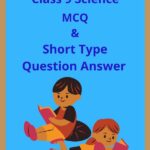Class 9 Science MCQ Chapter 1 Matter in our Surroundings, Class 9 Science MCQ Question Answer, Class 9 Science Multiple Choice Question Answer to each chapter is provided in the list of SCERT Science Class 9 Objective Types Question Answer so that you can easily browse through different chapters and select needs one. Class 9 Science MCQ Chapter 1 Matter in our Surroundings Question Answer can be of great value to excel in the examination.
SCERT Class 9 Science MCQ Chapter 1 Matter in our Surroundings
SCERT Class 9 Science MCQ Chapter 1 Matter in our Surroundings Notes covers all the exercise questions in SCERT Science Textbooks. The NCERT Class 9 Science MCQ Chapter 1 Matter in our Surroundings provided here ensures a smooth and easy understanding of all the concepts. Understand the concepts behind every chapter and score well in the board exams.
Matter in our Surroundings
Chapter – 1
Multiple Choice Questions & Answers
1. Intermixing of particles of two different types of matter on their own is called –
(a) diffusion
(b) sublimation
(c) evaporation
(d) humidity
Ans. (a) diffusion.
2. A change of state of matter directly from solid to gas without changing into liquid state is called.
(a) humidity
(b) sublimation
(c) fusion
(d) vaporisation
Ans. (b) sublimation.
3. A change of state of matter directly from gas to liquid is called-
(a) solidification
(b) fusion
(c) sublimation
(d) condensation
Ans. (d) condensation.
4. A change of state of matter directly from liquid to gas is called-
(a) fusion
(b) humidity
(c) vaporisation
(d) evaporation
Ans. (c) vaporisation.
5. A change of state of matter directly from solid to liquid is called
(a) fusion
(b) humidity
(c) sublimation
(d) evaporation
Ans. (a) fusion.
6. S.I. unit of temperature is –
(a) Pascal
(b) Newton
(c) Kelvin
(d) Celcius
Ans. (c) Kelvin.
7. Which is of the unit of temperature in the following –
(a) celcius
(b) pascal
(c) Newton
(d) litre
Ans.(a) celcius.
8. Which is the correct form in the following
(a) 0°C = 275k
(b) 0°C = 273k
(c) 0°℃ = 274k
(d) 0°℃=276k
Ans. (b) 0°C = 273k .
9. Dry ice means as
(a) Solid carbon dioxide
(b) liquid carbon dioxide.
(c) Calcium oxide
(d) Magnesium oxide
Ans. (a) Solid carbon dioxide.
10. Change of a liquid into vapours at any temperature below its boiling point is called –
(a) humidity
(b) fusion
(c) condensation
(d) evaporation
Ans. (d) evaporation.
11. The amount of water vapour present in the air is called –
(a) vaporisation
(b) humidity
(c) condensation
(d) vapour state
Ans. (b) humidity.
12. Which of the following temperature water changes to vapour state is?
(a) 273k
(b) 283k
(c) 373k
(d) 383k
Ans. (c) 373k.
13. Which of the following temperature water changes to solid state is?
(a) 573k
(b) 473k
(c) 373k
(d) 273k
Ans. (d) 27 k.
14. If the surface area is increased, then the rate of evaporation is –
(a) decreased
(b) remain same
(c) increased
(d) evaporation do not depend surface area.
Ans. (c) increased.
15. It is common observation that clothes dry faster on a.
(a) rainy day
(b) windy day
(c) cloudy day
(d) fogly day
Ans. (b) windy day.

Hi! my Name is Parimal Roy. I have completed my Bachelor’s degree in Philosophy (B.A.) from Silapathar General College. Currently, I am working as an HR Manager at Dev Library. It is a website that provides study materials for students from Class 3 to 12, including SCERT and NCERT notes. It also offers resources for BA, B.Com, B.Sc, and Computer Science, along with postgraduate notes. Besides study materials, the website has novels, eBooks, health and finance articles, biographies, quotes, and more.



It’s good but u have to add some more mcqs from chapter so it will help us